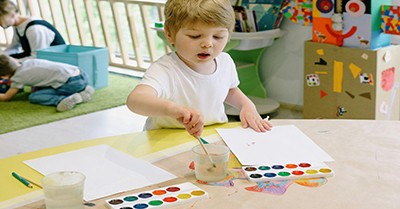Here’s a curated set of 20 child-centered art activity instructions designed to foster creativity, autonomy, and exploration. Each activity includes setup tips, educator role guidance, and EYLF/NQS links.
Mixed Media Collage: “My World in Layers”
Materials:
- Fabric scraps, colored paper, magazine cutouts
- Natural items (leaves, bark, feathers)
- Glue sticks, scissors, cardboard base
Instructions:
- Invite children to choose materials that “feel like their world.”
- Encourage layering, overlapping, and storytelling through textures.
- Ask open-ended questions: “What does this remind you of?” “What story is hiding here?”
Educator Role:
- Observe and document choices.
- Avoid directing placement or design.
- Support verbal or non-verbal storytelling.
EYLF Link: Outcome 1 (Identity), Outcome 5 (Communication)
NQS Link: QA1 (Program), QA5 (Relationships)
Abstract Emotion Painting: “Feelings in Colour”
Materials:
- Watercolors or tempera paints
- Brushes, sponges, droppers
- Large paper sheets
Instructions:
- Invite children to choose a feeling (happy, excited, worried, etc.).
- Ask: “What colors match that feeling?”
- Let them paint freely—no shapes or objects required.
Educator Role:
- Model emotional vocabulary.
- Reflect back: “I see lots of swirling blue—does that feel calm to you?”
- Document emotional connections.
EYLF Link: Outcome 3 (Wellbeing), Outcome 5 (Communication)
NQS Link: QA1, QA5
Nature Art: “Earth Treasures”
Materials:
- Leaves, stones, sticks, flowers
- Clay or playdough bases
- Magnifying glasses, baskets for collecting
Instructions:
- Go on a nature walk to collect materials.
- Invite children to arrange or embed items into clay.
- Encourage naming, pattern-making, or storytelling.
Educator Role:
- Facilitate respectful collection (no picking live plants).
- Support sensory exploration and inquiry.
- Link to sustainability and care for the environment.
EYLF Link: Outcome 2 (Community), Outcome 4 (Learning)
NQS Link: QA3 (Environment), QA1
Collaborative Mural: “Our Shared Story”
Materials:
- Butcher paper roll or canvas
- Paints, markers, stamps
- Photos, magazine images, glue
Instructions:
- Lay out a large shared surface.
- Invite children to add marks, images, or symbols over time.
- Use group reflection to build a shared narrative.
Educator Role:
- Facilitate turn-taking and respect for others’ contributions.
- Document evolving themes.
- Celebrate group identity.
EYLF Link: Outcome 2 (Community), Outcome 5 (Communication)
NQS Link: QA5, QA1
Artist-Inspired Exploration: “Kandinsky Circles”
Materials:
- Colored paper, oil pastels or crayons
- Images of Kandinsky’s work
- Scissors, glue
Instructions:
- Show children Kandinsky’s abstract circle art.
- Invite them to create their own layered circles.
- Ask, “What do your circles say about you?”
Educator Role:
- Introduce art history in accessible language.
- Encourage variation and personal interpretation.
- Avoid replication—focus on inspiration.
EYLF Link: Outcome 4 (Learning), Outcome 5 (Communication)
NQS Link: QA1, QA5
Salt & Watercolor Magic: “Rainy Day Wonder”
Materials:
- Watercolor paints, brushes
- White glue, table salt
- Thick paper
Instructions:
- Children draw with glue, sprinkle salt, and let it dry.
- Paint over the salt trails—watch colors spread and blend.
- Invite children to name their creations or invent stories.
Focus: Sensory exploration, cause-and-effect, storytelling
EYLF: Outcome 4 (Learning), Outcome 5 (Communication)
Shadow Tracing: “Dancing Shapes”
Materials:
- Toys or natural objects
- Paper, pencils, crayons
- Flashlight or sunlight
Instructions:
- Set up objects to cast shadows.
- Children trace outlines and decorate them.
- Ask: “What could this shape become?”
Focus: Observation, fine motor skills, imagination
EYLF: Outcome 4 (Learning), Outcome 2 (Community)
Bubble Wrap Printmaking: “Pop Art”
Materials:
- Bubble wrap, paint, rollers
- Paper, tape
Instructions:
- Roll paint onto bubble wrap.
- Press paper over it to reveal textured prints.
- Layer colors or cut into shapes for collage.
Focus: Texture, pattern, experimentation
EYLF: Outcome 4 (Learning), Outcome 5 (Communication)
Clay Creatures: “Tiny Worlds”
Materials:
- Air-dry clay or playdough
- Natural items, beads, sticks
- Small trays or boxes
Instructions:
- Children sculpt creatures or habitats.
- Add found materials for detail.
- Share stories or names for their creations.
Focus: Fine motor, storytelling, identity
EYLF: Outcome 1 (Identity), Outcome 4 (Learning)
Colour Mixing Lab: “What If Colors Could Talk?”
Materials:
- Primary paints, droppers, trays
- Paper towels or coffee filters
Instructions:
- Children mix colors freely and observe changes.
- Ask: “What do these colors remind you of?”
- Display results with color names invented by children.
Focus: Inquiry, language, experimentation
EYLF: Outcome 4 (Learning), Outcome 5 (Communication)
Further Reading
Art and Craft Descriptions With Links To The EYLF
50 Process Art Activities
20 Collaborative Art Projects For Preschoolers
Painting With Toddlers and Preschoolers
Andy Warhol Art Projects For Children
Claude Monet Art Projects For Children
Salvador Dali Art Projects For Children
Vincent Van Gogh Art Projects For Children
Pablo Picasso Art Projects For Children
